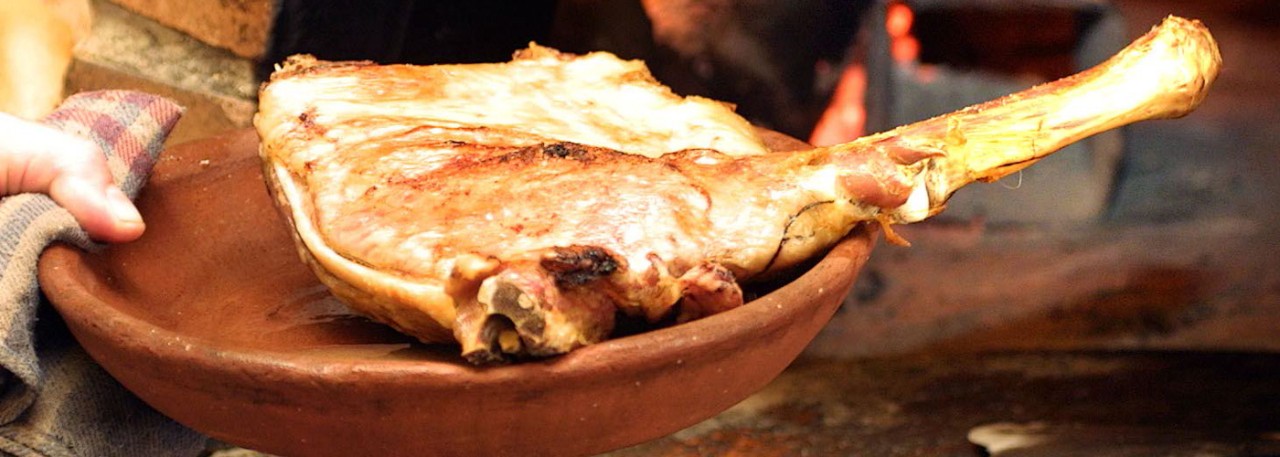.png.transform/rendition-xs/image_image%20(1).png)
Lechazo de Castilla y León PGI
Lamb from sheep of the Churra, Castellana and Ojalada breeds, or of crossbreeds among them. The term lechazo refers to suckling lambs, both male and female.
Tasting notes
Very tender meat, with very little intramuscular fat, very succulent and very smooth texture.
Other notes
In the geographical area of the Duero river, the term cordero lechal is also used for this meat.The color is pearly white or pale pink. To qualify as PGI Lechazo de Castilla y León, lamb must meet the following requirements:
- Lambs of either sex
- Live weight at slaughter in the slaughterhouse: nine to 12 kilos / 19-26 lb
- Age at slaughter: up to 35 days
Carcass weight:
- Without head or pluck and with omentum from 4.5 kg to 7 kg / 10-15 lb
- With head, pluck and omentum 5.5 kg a 8 kg / 12-17 lb
Fat characteristics:
- Waxy white external fat
- The omentum covers the carcass
- The kidneys are more than half covered
Production / Processing method
The only food lambs receive is their mother’s milk. Under no circumstances may the mothers receive growth promoters or finishers.
Lambs must be transported to the slaughterhouse in properly authorized vehicles in such a way that they do not suffer any type of stress or problems that might affect their condition or physical safety. Animals should not be lifted by the skin, nor struck, nor crushed together during transportation, which shall take place whenever possible during the morning, and long distances should be avoided. All the PGI lambs must be slaughtered on the day of entry into the slaughterhouse, always within a maximum of ten hours, and separated from other non-PGI animals.
The carcasses must be aired in cold rooms at 4ºC / 39ºF until the day after slaughter, and may not be sent out before that. After the first day, the carcasses must be chilled to 1ºC / 33º F, for a maximum of five days.
The maximum time for sale must be no more than eight days after slaughter, and the cold chain must remain unbroken at all times.
Geography / Relief and climate
The whole of the production area has the same relief, geology, climate, water sources, soils and agriculture. Its morphology is that of the north sub-meseta.
Of special significance for this region is the Duero river basin. This river collects and carries most of the water in Castile-León, although the territory also includes part of the basins of other large rivers, such as the Miño, Ebro and Tagus.
The relief and altitude are the most outstanding features of Castile-León, with 66.5% of its territory lying between 601 and 1,000 m (1971-3280 ft) above sea level. This high, flat ground is located in the center of the region. 31.4% of the region lies between 1,001 and 2000 m (3284-6561 ft) above sea level.
The climate is characterized by long, harsh winters with long, frequent periods of fog, as well as early and late frost. Summers are short and irregular, with scorching, arid periods alternating with cold periods. Temperatures vary between the average minimum of 5ºC / 41ºF and the average maximum of 18ºC / 64ºF, with extremes of 20ºC / 68ºF and 40ºC/ 104ºF respectively.
Two districts can be distinguished for rainfall: the central, flat area which is arid and has scarce rainfall, and the mountainous area with rain and a moderate summer drought.
Regulatory Council
Consejo Regulador de la IGP Lechazo de Castilla y León
Ctra. La Aldehuela, 23
49021 Zamora
980 040 016
info@lechazodecastillayleon.es
www.lechazodecastillayleon.es
Sources:
- Spanish Ministry of Agriculture
- Regulatory Council, Lechazo de Castilla y León PGI
- Department for Agriculture and Stockbreeding, Castile-León
The only food lambs receive is their mother’s milk. Under no circumstances may the mothers receive growth promoters or finishers.


- Lechazo 1
- Lechazo 2

Zamora (Castile-Leon)
